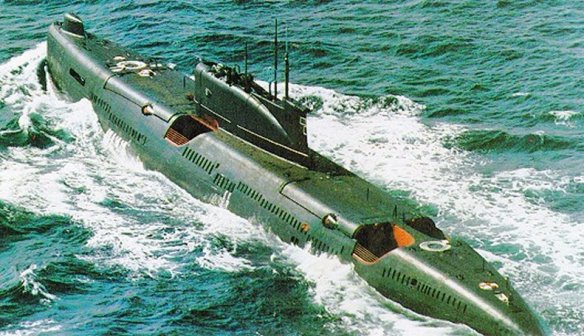The Project 651/Juliett SSG was an attractive submarine and, being diesel-electric, it demonstrated the scope of the Soviet commitment to the anti-carrier role. An auxiliary nuclear power source was evaluated for these submarines, but appears not to have been pursued.
Admiral S. G. Gorshkov, Commander-in-Chief of the Soviet Navy from 1955 to 1981, used the term “revolution in military affairs” to describe the period of the late 1950s when cruise and ballistic missiles were integrated into the Soviet armed forces. For the Soviet Navy this led to an intensive period of development of cruise missiles, initially for the land-attack role and then for the anti-ship role, as well as the development and construction of several cruise missile submarine designs. Gorshkov observed that “. . . all the latest achievements in science, technology, and production were utilized in the course of building qualitatively new submarines, surface ships, and [their] armament.”
Significantly, of the 56 first-generation (HEN) nuclear-propelled submarines built in the Soviet Union, slightly more than half of them (29) were Project 675/Echo II cruise missile submarines. While this proportion was achieved, in part, by the termination of Project 658/Hotel ballistic missile submarine program, when considered together with the 16 Project 651/Juliett SSGs, cruise missiles represented a major Soviet investment to counter U. S. carriers that could threaten the Soviet homeland with nuclear-armed aircraft.
This was in sharp contrast to the U. S. Navy. Having aircraft carriers available for the anti-ship as well as for the land-attack roles, the U. S. Navy rapidly discarded cruise missile submarines as the Polaris ballistic missile became available.
Simultaneous with the building of Project 675 Echo II SSGN nuclear submarines, the Project 651/Juliett diesel-electric submarine was put into production. It had a submerged displacement of 4,260 tons and was 2813/4 feet (85.9 m) long. Missile armament consisted of four P-5/P-6 canisters, paired in the same manner as in the SSGNs. This was a TsKB-18 design under chief designer Abram S. Kassatsier.
Seventy-two Project 651/Juliett submarines were planned. In the event, only 16 of these submarines were built at Gor’kiy and the Baltic shipyard in Leningrad from 1963 to 1968. As with Project 675/Echo II submarines, these craft had a large, rotating radar in the leading edge of their sail, with one of these submarines later having a satellite targeting system fitted (Project 651K). The first few submarines were built with low-magnetic steel. These soon suffered significant corrosion damage as well as cracks. The later submarines were of standard steel construction.
The building of diesel-electric SSGs in parallel with nuclear SSGNs occurred because of limitations at that time in producing additional nuclear reactors. Because Juliett SSG construction was contemporaneous to the Echo II SSGN and other factors, some U. S. submarine analysts believed that there was “sufficient evidence to warrant at least consideration of the possibility that, with the advent of nuclear power, the Soviet Union, in addition to continuing the development of conventional diesel-electric submarines, also advanced the development of unconventional nonnuclear [closed-cycle] propulsion systems.” But the Project 651/Juliett SSG had conventional propulsion- except for one unit.
A small nuclear reactor-designated VAU-6- was developed to serve as an auxiliary power source in diesel-electric submarines. It was a pressurizedwater reactor with a single-loop configuration coupled with a turbogenerator. After land-based trials it was installed in a Juliett (Project 651E) during 1986-1991. The sea trials “demonstrated the workability of the system, but revealed quite a few deficiencies. Those were later corrected.” In 1960, on the basis of Project 651, the Project 683 nuclear-propelled submarine was designed, also to carry the P-5/P-6 missiles. This was to have been a larger craft with more weapons; two small, 7,000-horsepower reactor plants were to propel the submarine. However, this design was not further developed.
Submarines with anti-ship cruise missiles were developed specifically to counter U. S. aircraft carriers, which since 1950 carried nuclear-capable strike aircraft on forward deployments to within range of targets within the Soviet Union. The high priority of defense of the Soviet homeland against this threat led to major resources being allocated to the SSG/SSGN construction. From 1963 to 1968 a total of 50 “modern” missile-armed submarines of the Juliett, Echo I, and Echo II classes were sent to sea carrying 326 missiles. These submarines, in turn, forced an increase in U. S. tactical anti-submarine warfare. While on the surface the SSG/SSGNs were increasingly vulnerable to Allied detection, although they were immune to the aircraft-carried Mk 44 and Mk 46 ASW torpedoes, which could not strike surface targets. This led to development of the Harpoon anti-ship missile for use by aircraft to attack cruise missile submarines on the surface. (The Harpoon subsequently became the U. S. Navy’s principal anti-ship weapon; it was carried by aircraft, surface ships, and, briefly, submarines.)
Cruise missile submarines thus became a mainstay of the Soviet Navy. With both cruise missile and a torpedo armament, these submarines provided a potent threat to Western naval forces. Indeed, some Project 675/Echo II and Project 651/Juliett submarines remained in service into the early 1990s.
